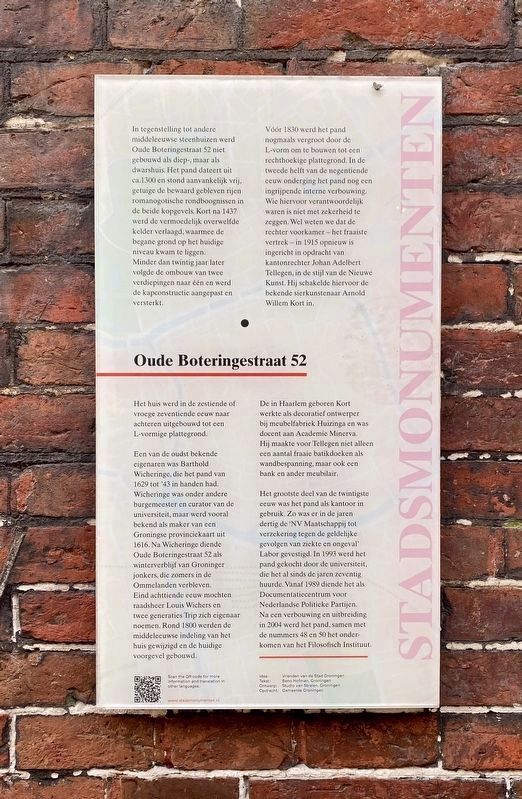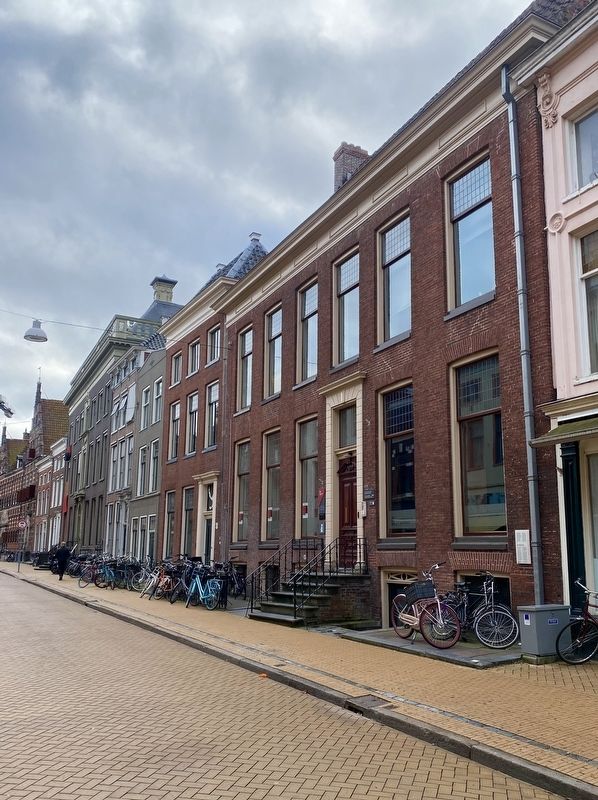Groningen, Netherlands — Northwestern Europe
Oude Boteringestraat 52
— Stadsmonumenten —
In tegenstelling tot andere middeleeuwse steenhuizen werd Oude Boteringestraat 52 niet gebouwd als diep-, maar als dwarshuis. Het pand dateert uit ca.1300 en stond aanvankelijk vrij, getuige de bewaard gebleven rijen romanogotische rondboognissen in de beide kopgevels. Kort na 1437 werd de vermoedelijk overwelfde kelder verlaagd, waarmee de begane grond op het huidige niveau kwam te liggen. Minder dan twintig jaar later volgde de ombouw van twee verdiepingen naar één en werd de kapconstructie aangepast en versterkt. Het huis werd in de zestiende of vroege zeventiende eeuw naar achteren uitgebouwd tot een L-vormige plattegrond.
Een van de oudst bekende eigenaren was Barthold Wicheringe, die het pand van 1629 tot ’43 in handen had. Wicheringe was onder andere burgemeester en curator van de universiteit, maar werd vooral bekend als maker van een Groningse provinciekaart uit 1616. Na Wicheringe diende Oude Boteringestraat 52 als winterverblijf van Groninger jonkers, die zomers in de Ommelanden verbleven. Eind achttiende eeuw mochten raadsheer Louis Wichers en twee generaties Trip zich eigenaar noemen. Rond 1800 werden de middeleeuwse indeling van het huis gewijzigd en de huidige voorgevel gebouwd.
Vóór 1830 werd het pand nogmaals vergroot door de L-vorm om te bouwen tot een rechthoekige plattegrond. In de tweede helft van de negentiende eeuw onderging het pand nog een ingrijpende interne verbouwing. Wie hiervoor verantwoordelijk waren is niet met zekerheid te zeggen. Wel weten we dat de rechter voorkamer – het fraaiste vertrek – in 1915 opnieuw is ingericht in opdracht van kantonrechter Johan Adelbert Tellegen, in de stijl van de Nieuwe Kunst. Hij schakelde hiervoor de bekende sierkunstenaar Arnold Willem Kort in. De in Haarlem geboren Kort werkte als decoratief ontwerper bij meubelfabriek Huizinga en was docent aan Academie Minerva. Hij maakte voor Tellegen niet alleen een aantal fraaie batikdoeken als wandbespanning, maar ook een bank en ander meubilair.
Het grootste deel van de twintigste eeuw was het pand als kantoor in gebruik. Zo was er in de jaren dertig de ‘NV Maatschappij tot verzekering tegen de geldelijke gevolgen van ziekte en ongeval’ Labor gevestigd. In 1993 werd het pand gekocht door de universiteit, die het al sinds de jaren zeventig huurde. Vanaf 1989 diende het als Documentatiecentrum voor Nederlandse Politieke Partijen. Na een verbouwing en uitbreidingin 2004 werd het pand, samen met de nummers 48 en 50 het onderkomen van het Filosofisch Instituut.
(English version from Stadsmonumenten.nl:)
In contradiction to other medieval stone houses Oude Boteringestraat 52 was not built as a deep- but as a diagonal house. The building dates from ca.1300 and was initially detached, witnessing the preserved rows of Romanesque-gothic roundly arched niches in the two end walls. Shortly after 1437, the supposedly vaulted cellar was lowered, which placed the ground floor at its current level. Less than twenty years later, the conversion of two floors to one followed and the roof structure was modified and strengthened. The house was developed backward into an L-shaped floor plan in the sixteenth and early seventeenth centuries.
One of the oldest known owners was Barthold Wicheringe, who owned the building from 1629 to '43. Wicheringe was among other things, mayor and trustee of the university, but was best known as a maker of a province map of Groningen in 1616. After Wicheringe, Oude Boteringestraat 52 served as a winter stay for Groninger Jonkers, who spend their summers in the Ommelanden. Councilor Louis Wichers and two generations of Trip could call themselves owners in the late eighteenth century. The medieval layout of the house was changed around 1800 and the current façade was constructed.
Before 1830 the property was enlarged again by converting the L-shape into a rectangular floor plan. In the second half of the nineteenth century, the building underwent a major internal renovation. It cannot be said with certainty who was responsible for this. We do know that the front room on the right - the finest room - was redesigned in 1915 commissioned by sub-district court judge John Adelbert Tellegen, in the style of the New Art. He involved the previously known decorative artist Arnold Willem Kort. Born in Haarlem Kort worked as a decorative designer at a furniture factory named Huizinga and was a lecturer at Minerva Academy. He made for Tellegen not just some beautiful batik cloths and wall coverings, as well as a sofa and other furniture.
The largest part of the twentieth century the building was used as an office. The "SA Society for insurance against the financial consequences of sickness and labor accidents" used the building in the thirties. In 1993 the building was purchased by the university, who had been rented it since the seventies. From 1989 it served as the Documentation Centre for Dutch Political Parties. After a renovation and expansion, the building became in 2004, along with the numbers 48 and 50 the home of the Philosophical Institute.
Erected by Gemeente Groningen. (Marker Number 93.)
Topics and series. This historical marker is listed in these topic lists: Architecture • Education • Industry & Commerce. In addition, it is included in the Groningen Stadsmonumenten series list. A significant historical year for this entry is 1300.
Location. 53° 13.226′ N, 6° 33.803′ E. Marker is in Groningen. Marker is on Oude Boteringestraat, on the right when traveling south. Touch for map. Marker is at or near this postal address: Oude Boteringestraat 52, Groningen 9712 GD, Netherlands. Touch for directions.
Other nearby markers. At least 8 other markers are within walking distance of this marker. Oude Boteringestraat 44 (within shouting distance of this marker); Oude Boteringestraat 36-38 (about 90 meters away, measured in a direct line); Doopsgezinde Kerk / Mennonite Church (about 90 meters away); Huis met de Dertien Tempels / House with the Thirteen Temples (about 120 meters away); Spilsluizen 1-3 (about 210 meters away); Oude Ebbingstraat 39 (about 210 meters away); Het Soephuis / The Soup House (approx. 0.3 kilometers away); Chez Dicque (approx. 0.3 kilometers away). Touch for a list and map of all markers in Groningen.
Credits. This page was last revised on December 31, 2023. It was originally submitted on January 8, 2023, by Andrew Ruppenstein of Lamorinda, California. This page has been viewed 82 times since then and 22 times this year. Photos: 1, 2. submitted on January 8, 2023, by Andrew Ruppenstein of Lamorinda, California.

